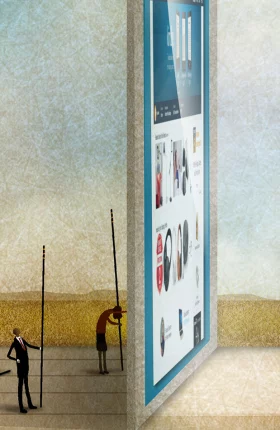A few retailers may have grown faster and further than Amazon, but none has had as disruptive an impact on consumer behavior or on the retail sector. Amazon has changed the way much of the world shops. And it continues to innovate, testing and often scaling up new models and services with mind-boggling speed and frequency. BCG partner and managing director Gabrielle Novacek recently shared her views on how CPG manufacturers can win by working with Amazon.
This interview is part of the series “ The Winner-Take-All Digital World in CPG ,” cosponsored by The Boston Consulting Group (BCG) and the Grocery Manufacturers Association (GMA), which looks in-depth at some of the changes in the consumer packaged goods (CPG) industry and presents potential strategies that CPG companies can pursue in response. The series is based on research conducted collaboratively by BCG and the GMA as well as on BCG client experience.
Does a CPG company with a strong brand, solid market share, and good growth really need to adjust its strategy for Amazon?
The point that CPG companies need to understand is that about half of all growth in the US market is likely to be online, and strong brick-and-mortar market share does not necessarily translate to the digital world. CPG companies should plan for a “1-5-10” market in the US over the next four to five years, which means that e-commerce’s current roughly 1% to 2% grocery penetration will most likely expand to 5% but could quickly accelerate to 10%, or more in certain categories and geographies. As digital channels grow, companies can’t rely on the skills and approaches they’ve used in traditional channels if they want to win in digital—which is critical to continued overall growth. They need an effective digital capability to avoid stagnation, share loss, or, in some categories, shrinking sales.
An effective digital strategy has to address Amazon. The e-tailer is not only the biggest US online store, it is also where shoppers in traditional stores go to compare products, deals, and prices. It has outsize influence throughout the consumer goods sector. Amazon also has some 41 million Prime members—35% of US households. Its goal is to gain more and more share of total household spending by offering optimal prices, selection, and convenience, and it is highly sophisticated in managing both product and total manufacturer profitability. It continually pilots and rolls out new models and services—including Amazon Prime, Prime Now, Prime Pantry, Dash, Subscribe & Save, and AmazonFresh—several of which take direct aim at disrupting traditional CPG sales models. Amazon has become the 800-pound gorilla in the retail room, especially in the US; it’s the retailer for which every CPG company needs a strategy.
What makes Amazon so different, from a CPG manufacturer’s point of view?
Three things, at least: its ambitions, its business model, and its interaction with the companies whose products it sells. All three represent big departures from the brick-and mortar retailers that most CPG companies are used to doing business with. They are also different from traditional retailers’ e-commerce operations and the models pursued by emerging e-commerce specialty players.
Take ambition: most grocers and big-box retailers seek to maximize revenues while protecting margins. Their entire system—from supply chain through marketing and promotion—is designed to sell a lot of the leading brands in any given category. This aligns their goals with those of CPG’s market leaders. But, as I noted, Amazon’s goal is different: it wants to get a bigger and bigger share of the household budget for everything. Amazon is a lot less concerned with whether a product or brand is a category leader so long as it is a sales leader on Amazon.com or on one of the company’s other sites or apps. Moreover, Amazon is not particularly worried about its margins for any individual item. The company looks at things from the perspective of total household spending—in other words, the profit that it draws from each family as a share of that family’s total spending in the marketplace—which can be a problem for CPG companies because they don’t generally operate on those terms.
Now look at business models. Amazon’s are constantly evolving. Or put another way, the company keeps innovating and testing new models with almost startling frequency, and it’s not afraid to fail. Remember, it began life 20-plus years ago as a bookseller. Then it moved into other categories, such as music, electronics, and apparel. Now it sells almost everything. It tried the auction model in the late 1990s, and when that didn’t take off, it morphed the business into Amazon Marketplace for third-party sellers. It’s the biggest marketplace of its kind in the US today. Amazon entered grocery in 2003, it built up Amazon Prime, and it has since started Subscribe & Save, Prime Pantry, AmazonFresh, and Prime Now for same-day delivery. Amazon Dash de-links the act of purchasing from the computer or smartphone. It enables Prime customers to reorder popular products at the touch of a button in their kitchen or laundry room.
Think about Amazon Flex, launched in 2015, which addresses the “last mile” portion of delivery, the final—and usually the most expensive—stretch of a package’s journey from warehouse to customer. The last mile has become increasingly important to Amazon as shoppers expect cheaper and faster delivery. Amazon Flex works like on-demand ride-hailing service Uber. Drivers—or in some areas, bike riders—use the app to sign up for shifts to pick up packages at small warehouses near metropolitan areas, rather than at Amazon’s massive fulfillment centers, and deliver them to customers’ doors. Drivers can schedule shifts between 8:00 am and 4:00 pm seven days a week, and Amazon says they can make $18 to $25 an hour. The program is now available in 14 cities, including Seattle, Las Vegas, Phoenix, and Dallas.
And its aspirations go beyond dominating grocery. In 2015, Amazon launched Amazon Business to further its quest in the B2B sector. Its projected volume in 2016 is more than $5 billion.
Not every model succeeds, or succeeds to the same extent, but all support the goal of seizing more of the household budget. And each has its own implications for CPG companies in such areas as supply chain, packaging, and marketing—implications that are very different from doing business with traditional retailers.
Let’s talk about the implications. What do CPG companies need to do differently to succeed with Amazon?
Remember Amazon’s goal—to gain a greater share of household spending. Companies can support Amazon by focusing on total contribution dollars. On one hand, this means maximizing profitable sales by boosting volume, concentrating on profitable items and remembering that prices will be tested by Amazon’s dynamic pricing algorithm. It also means advertising through the Amazon Media Group because part of Amazon’s model is driving advertising revenue as more people visit the site. On the other hand, it means minimizing negative returns. This involves adopting Amazon-optimized product design, managing inventory actively and adapting supply chains dynamically to avoid stock-outs, monitoring and delisting unprofitable items, minimizing freight administration costs, and complying with Amazon reporting processes. These are table stakes at Amazon, but some companies balk because they feel it’s a lot of time and resources to invest in one channel.
And that’s a mistake, in your opinion?
It’s a mistake based on the facts. Amazon has about a 30% share of US nonstore grocery revenues, and its sales of grocery items has been growing at about 30% a year for the last several years. Because it continues to innovate with new business models, it is almost a channel unto itself. So, yes, if they want to continue to grow, even the strongest CPG brands need to have a strong presence on Amazon and an Amazon strategy to ensure “first-page success.”
Talk more about getting an Amazon strategy right. What’s first-page success?
The first and most important point is to analyze the overall profitability of the relationship from Amazon’s point of view. That’s what Amazon management is looking at. There are some basic things any company needs to do. First-page success is a good example. There’s a myth out there that online shelf space is endless, that one of the big reasons Amazon and other e-tailers are so popular is that they offer an endless variety of SKUs. That’s true, but it’s also misleading. Consumers don’t necessarily scroll down through that endless variety. They are much more likely to choose from the initial selection they see—the first page on a laptop or the first screen on a smartphone. We’ve produced a nice little infographic that shows this process at work. (See “ The Myth of Unlimited Shelf Space ,” BCG infographic, May 2016.)
As my colleague, Karl Walsh, another BCG digital and e-commerce expert, often points out, companies need to make sure that they are present on that first page. Because that page is algorithm-driven, that means maximizing sales using the tools available. One tool is search engine optimization: how well does a company optimize keywords and product volumes on a regular basis to drive page-one ranking for Amazon search results? Another is managing online product content. Does the company include a sufficient number of up-to-date, high-quality images and put in place concise, informative, and keyword-optimized product descriptions? Does the “From the Manufacturer” section on a product’s Amazon page include interactive content, instructions, endorsements, and other additional information? Then there are online reviews. What has the company done to ensure critical mass of good user reviews? Does it participate in Amazon’s Vine and Official Comment programs?
Companies also need to decide which products they will make eligible for Prime as well as Subscribe & Save, decisions that have both revenue and profitability ramifications. Among Amazon.com’s 100 bestsellers, 88% are Prime eligible. Subscribe & Save has bigger economic implications for the manufacturer given steep discounts. Almost 60% of bestsellers offer it, mainly because it does drive ongoing purchase, and therefore, in the long term, while individual purchases may be at lower margin, the total margin over time is larger.
To build an overall relationship, they also need to advertise with Amazon. From the company’s point of view, it’s akin to trade spending to drive product placement. From Amazon’s perspective, it’s part of a broader manufacturer P&L.
What about areas other than marketing?
Many of these, such as supply chain, are just as important. CPG companies need to think about adapting their supply chains to serve the Amazon channel. This means adjusting distribution to send more products to Amazon fulfillment warehouses and maintaining in-stock availability. It also means keeping up with the proliferation of Amazon warehouses and fulfillment models. Amazon is vastly increasing—it recently announced plans to lease a fleet of aircraft and build out a ground network of couriers and new warehouses near urban centers. Packaging is another key area. Companies need to redesign packaging for Amazon warehouse picking and parcel shipping . As Amazon’s capabilities in robotics evolve, there may be a need to adapt packaging for new systems.
Companies also need to think about pricing. While they cannot set or negotiate prices on Amazon—Amazon’s dynamic pricing model constantly tracks and responds to price fluctuations in the marketplace—they do need to manage profitability if prices drop too low, even by considering delisting. They also need to avoid pricing discrepancies with other retailers where they have more control over prices. We are seeing more companies put in place strategies to manage the overall channel conflict that emerges from Amazon’s prices. Some, for example, create slightly different pack sizes so it becomes harder to make direct comparisons.
You mention not being able to negotiate. This raises the question of how a CPG company goes about building a relationship with Amazon.
It’s not easy, but there are some effective ways. One is to work on becoming a preferred partner, which starts with building dedicated relationships. There are three levels of vendor relationships at Amazon.
The first is third-party sellers, or merchants. Amazon makes it easy for anyone to sell through its system, and these are typically individuals or small businesses, mostly using pay-as-you-go payment systems and handling their own listings and shipping. They have no point or contact at the e-tailer.
First-party sellers, or vendors, tend to be smaller manufacturers, although the correlation to size is imperfect. They are allowed to control product content and manage distribution, and they’re given access to Amazon’s promotional and marketing programs. They also have no point of contact at the company. But many of these are real competitors for big CPG brands.
Strategic partners are major suppliers that Amazon regards as premium partners. These are the large manufacturers marketing national or global brands. Because of their size and importance, they are afforded the opportunity for greater contact, and they also have the potential for inclusion in strategic initiatives, such as the opportunity to be early participants when Amazon rolls out new initiatives or business models.
Strategic partners make a big commitment to Amazon. As a starting point, they offer a broad assortment of brands and products rather than just a few items. They invest in Amazon’s Strategic Vendor Services (SVS) in order to receive an assigned vendor manager, among other things. Interactions with the e-tailer are conducted at very senior levels. They also develop senior contacts within Amazon to share consumer and shopper insights, based on their expertise within the grocery category. SVS provides manufacturers opportunities to sell more strategically and to build other Amazon relationships. CPG manufacturers can fund a single point of contact through SVS. But it comes at a cost and does not solve all Amazon challenges.
CPG manufacturers can establish further credibility with Amazon by keeping pace with expansion of the company’s newer retail concepts and business models, such as AmazonFresh, Prime Now, and click and collect. Amazon is exploring multiple avenues to achieve its ambition of becoming the number-one retail destination, including building out its logistical capabilities. There is the potential for significant first-mover advantage by working closely with Amazon as it develops these new business models—although it generally requires a fair amount of internal investment, which can be risky because Amazon can move on from models that show limited success very quickly.
It’s a complicated new world.
A lot more complicated than it used to be, that is for sure. But as I said at the outset, CPG brands have to be present in digital channels to continue to grow, and Amazon is the number-one digital channel. Making the investment of time and resources, learning how to play in this game, are essential for both maintaining sales growth and building brands. There’s also a broader benefit that should not be overlooked—the processes, tools, and capabilities that companies build working with Amazon can all be put to effective use in other digital channels, such as click and collect and some of the newer business models we are seeing come into play. These will be the subjects of a future piece in our series.





